automotive design
Fiat Happenings

Scattered around Australia are numerous Fiat outlets with showroom teams that are willing to buy, sell and service any of their special brand of car. You’ll find a Fiat showroom in Perth, Adelaide, Melbourne, Canberra, Sydney, Wollongong, Brisbane and on the Sunshine Coast. There are even more places around Australia who are experts in servicing or accessing parts for your Fiat or Fiat Abarth vehicles. This leaves you very little need to hold off being the proud owner of a new or used Italian legend should you so desire.
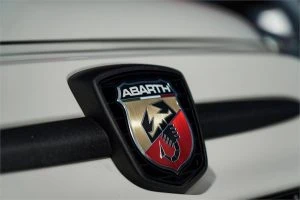
New 2021/2022 Fiat vehicles offer a variety of small 4- and 5-seater cars that come as standard little hatchbacks or hatchbacks with a bit more Abarth pep and performance. The Abarth brand are the performance models that are special Fiat 500s with lots of fun and plenty of zip to make your drive both entertaining and unique. The standard Fiat 500 is a surprisingly roomy small car that is comfortable and efficient to drive.
Fiat also does a range of commercial vehicles that are mainly a variety of medium and large vans. These are popular vans for businesses because Fiat offer their range of modern, safe vans at a reasonable price, and the team are willing to back their vans up with a competitive servicing and warranty package for any of their new Fiat-commercial-model buyers. Fiat also offer the Ducato in a range of motorhome and camper styles.
Fiat really is a quintessential “Made in Italy” stamp with all its Italian history, style, constant innovation and decent quality being part of the modern range. The recent Fiat 500 has seen 80% of its sales outside of Italy, and it is a model that leads the city car segment in Europe together with its cute little sibling, the Fiat Panda.
Recently, the introduction of the Hybrid Fiat 500 and Panda has given an extra boost to the sales of both models. These are exceptionally economical cars. In Italy, the stylish Fiat 500X has been refreshed, ready to continue playing a leading role in many Italian family’s lives. Indeed, since its launch in 2014, the Fiat 500X has always led its segment in Italy, and the car regularly features in the European top 10 small-car segment.
Recent news from Fiat in Europe has seen some other new model launches, which would also be nice to see become available here in Australia – particularly for those of us who want to get the benefits of driving a small and efficient car with Italian style. The final months of last year saw the new Fiat 500, Tipo, Tipo Cross and Panda range, and so Fiat has brought 2021 around with the entire line-up of cars being completely refreshed.
A lot of effort has gone into providing new Fiats and Abarths with all the latest technology, safety, comfort and style for each new variant. New models also boast Euro 6D-Final-compliant engines across the entire range. The Connect trim level is directed at customers who want to stay connected at all times. Models with Connect come standard with the 7-inch Uconnect infotainment system with DAB radio, Apple CarPlay and Android Auto, the easy and efficient way to exploit the services of your device while travelling in your car.
Standard features of the 2021 Fiat 500 also includes cruise control, a sports steering wheel with built-in controls, 15-inch alloy wheels and fog lights. You can also select the dedicated new Perbene Grey/Vesuvius Black two-tone insignia. The 2021/2022 Fiat 500X comes with black seats, a techno-leather steering wheel, 16-inch alloy wheels, blacked-out windows, fog lights, LED DRLs, parking sensors, along with dusk sensors and rain sensors.
Here is a picture of the stunning little Abarth F595. Check out the gorgeous body kit and quad exhausts!
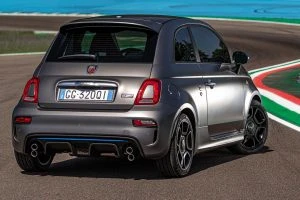
Abarth F595
New EV SUVs
We still seem to be desiring the SUV over other shapes and styles of car. This is for reasons that I can understand; things like safety, space and ride comfort tend to be found in spades when you travel inside a decent-size SUV. Because we are likely to go through a period of history where the EV may well rule the road, are there any SUV-type EVs available now? EVs aren’t selling like hot cakes just yet, but there some EV SUVs bigger than a pint-sized Honda E that you might be interested in. It turns out that, actually, there are some pretty decent EV SUVs available to the buyer loaded with cash. As yet, they aren’t the cheapest vehicles on the planet, particularly if they are of the premium luxury brands, but it’s nice to know that if you did have the money, and wanted a spacious and desirable luxury model, they are already being sold out on the market.
Tesla has the jump on its competition, and they already have a decent wodge of EV clients under their wings. Because it was pretty much the first EV manufacturer to design and build a decent EV, it was Tesla who soaked up the early adopters of Tesla’s EV technology, and it was these buyers who were very keen to align and embrace the new EV technology early on. What is happening now, is that because other manufacturers are only now getting fully into the swing of EV technology, the keenest buyers have already been wooed and taken by Tesla, so, for instance, if you are an Audi e-tron or Jaguar I-Pace, you have a slightly harder job of getting your buyers because you have to actually entice them away from their luxury ICE vehicles and into one of their EV variants.
Tesla Model X
Let’s first give credit where credit is due, and let’s talk about the Tesla Model X EV SUV. The Model X can come with an optional six seats, the middle row boasting full-on Captain’s chairs. The five-seat Model X is the standard guise. I love the falcon-wing doors; they look so cool and make life very easy getting in and out of the car – even in tight parking spaces with as little as 11-inches on either side. Tesla’s Model X cabin is nice, big, and comfortable. Up the front, there is a big infotainment display screen on the dash. This is as big and as good as it gets in any car. The roof/ceiling is also a huge display screen, which is tinted so that the glare from the sun is minimised. The Tesla feels extremely modern but also, at the same time, quite a simple car that is fun to live with. It has funny features like a Fart Mode, which is an emissions testing mode that allows the car to perform fart sequencing and farting whenever it requires to do so. People outside don’t escape the sounds either. This feature does leave one in hysterics – you have been warned! The Tesla Model X is very different to anything else on the road, and that makes it a unique drive. Out on the road, the Tesla Model X is quick, and its ride does a pretty good job of soaking up the bumps. There are better handling cars like the Audi e-tron and Jaguar I-Pace, however.
- Twin electric motors
- 100kWh battery
- Weight: 2459 kg
- Range: Claimed at over 500 km, real world driving more likely to be around 300 km.
- 310 kW of power
- 660 Nm of torque
- Top speed: 250 km/h
- 0-100 km/h: 4.9 seconds
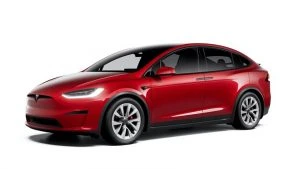
Tesla Model X
Audi e-tron
Audi’s new e-tron has five seats, all rather comfortable and impeccably crafted. The touchscreen system is classy, right up-to-date, and detailed. You do have plenty of menus to work through before finally getting to where you want to be in the infotainment set-up. On the road, the Audi e-tron is exceptionally well-sorted. It feels really tight around the corners, smooth and very quiet. Though EVs are generally heavy vehicles, the e-tron disguises its mass very well, indeed. There is plenty of well thought-out storage compartments throughout the cabin, and on a day-to-day basis this is a nice EV SUV to live with.
- Twin electric motors
- 95kWh battery
- Weight: 2490 kg
- Range: Claimed at around 385 km, real world driving more likely to be around 300 km.
- 300 kW of power
- 664 Nm of torque
- Top speed: 200 km/h
- 0-100 km/h: 5.7 seconds

Audi e-tron
Volvo XC40
Volvo’s XC40 Pure Electric Hybrid is a smaller luxury EV SUV. Safety features include autonomous emergency braking, run-off-road assist and up to Level 2 self-driving in heavy traffic situations. It’s available with AWD and uses a nice silent, smooth electric set-up. The Volvo’s version of an EV SUV is a gem. The XC40 looks and feels very modern, and the XC40’s cabin is impressively spacious. Standard equipment levels are high and include a 12.3-inch digital instrument panel with configurable EV-specific displays, panoramic sunroof, heated front power seats, and inductive charging for your smartphone. Also standard, is the full suite of Volvo safety features, including lane keep assist, blind-spot and cross-traffic alert, and rear collision alert. The 460 litres of boot space opens up to 1336 litres with the rear seats folded down flat. These can be bought new for around $85k, making this a well-priced premium luxury EV SUV that is comfortable and swift.
- Twin electric motors
- 78kWh battery
- Weight: 2158 kg
- Range: Claimed at around 418 km, real world driving more likely to be around 300/350 km.
- 300 kW of power
- 659 Nm of torque
- Top speed: 180 km/h
- 0-100 km/h: 4.7 seconds
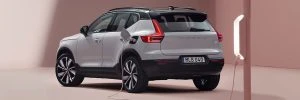
Volvo XC40 Recharge Electric
Jaguar I-Pace
In my opinion, the Jaguar I-Pace wins the EV SUV beauty contest. From every angle it looks nice, athletic, and the perfect blend of old and new design. Even with its GT lines there is a nice amount of space inside the EV Jag. To drive, the Jaguar I-Pace is wonderful. It feels very crisp through the corners and it even has a satisfying growl that flows through the speaker system as you plant your right foot and accelerate hard. Compared with its rivals, the new Jaguar I-Pace weighs in at a comparatively light 2.0 tonnes. This is a lovely EV SUV and is probably the one I’d prefer most of all the snobbish EV SUVs currently on sale.
- Twin electric motors
- 90kWh battery
- Weight: 2068 kg
- Range: Claimed at around 420 km, real world driving more likely to be around 300 km.
- 294 kW of power
- 695 Nm of torque
- Top speed: 200 km/h
- 0-100 km/h: 4.5 seconds
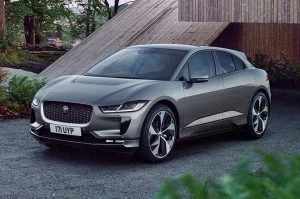
Jaguar I-Pace
BMW’s latest iX and Mercedes Benz’s EQC are some other luxury EV SUVs worth a look at. And then some other considerations that are substantially cheaper than the premium EV SUVs mentioned above would be the small Mercedes-Benz EQA and the very good MG ZS EV, Hyundai Kona and Kia Niro.
Some big reasons why you’d want to change to a EV SUV right now would be the driving smoothness, the driving silence, self-driving safety features, and the potential for saving money at the “pump”. I think it was Top Gear who recently suggested that, on average, the running costs of one of these were on a par with an equivalent petrol car capable of 73 mpg (3.2 litres/100 km). That’s if you were to do most of your charging at home and not at public charging stations.
A Case for Hydrogen-Powered Cars
What’s to like about hydrogen, and hydrogen-powered cars? We cannot see taste or even smell hydrogen, yet hydrogen makes up over 90% of matter. The stars and the sun are made up of hydrogen gas. Here on earth, hydrogen forms compounds; compounds are a mixture of elements that we find on the Periodic Table (That’s the big poster found in every science lab at school, which has 120 – or so – little squares with letters that make up the organised Periodic Table with all the known elements in our world.). Hydrogen is found in almost every living thing. Hydrogen gas is used to make chemicals such as ammonia and methane. Hydrogen is in the water that we drink (H2O). Some car manufacturers and scientists have been beavering away developing what is known as hydrogen-powered cars.
Before the car was even invented, hydrogen power had been around and in use in various forms since the 1800s. It was used widely for gas streetlamps back in the day. It was a Welshman, Sir William Robert Grove, who invented the first fuel cell back in 1839. When you use hydrogen in a fuel cell, the only thing you produce is electricity and water!
So, hydrogen-powered cars are vehicles that contain tanks of hydrogen fuel that then combine with oxygen from the air in a process that delivers power to the car for motion. The beauty of the hydrogen-powered vehicle is they produce only water as a waste product.
In a little bit more detail, a hydrogen fuel cell inside a hydrogen-powered car works like this… The fuel cell has a proton exchange membrane that uses compressed hydrogen and oxygen from the air to produce electricity. The hydrogen goes into the membrane at one end called the anode, while oxygen goes into the membrane at the other end called the cathode. A platinum catalyst, which is positioned on the anode end of the membrane, splits the hydrogen into positive protons and negatively charged electrons. The proton exchange membrane takes only the positive ions, while the electrons are fed into a circuit to make electricity. It’s this electricity which is used to drive the car’s electric motor[s]. These electric motors are what provide the driving for the hydrogen-powered car to give them speed and power!
At the cathode end, the positive ions are travelling along the membrane and combining with oxygen from the air to make water (H2O). This water drips out of the car’s exhaust/tailpipe. If you are driving your hydrogen-powered car through a desert and need some water, then you could believably drink it. Now, how green is that!
How can we produce hydrogen for vehicles? Without going into too many details here (I’ll save that for another blog), hydrogen can be produced in mass from a renewable electricity system that uses generation plants like hydro dams, solar power and wind power generators. This purpose-made hydrogen is known as green hydrogen. Australian mining company, Fortescue, has been talking with government recently regarding the creation of a hydrogen production system for Australia as early as 2023/24.
Tiwai point, which you’ll find on the Southern-most tip of New Zealand (NZ makes up Australia’s two biggest islands!), is currently being used as an aluminium smelter. The NZ government is in talks for designing and consenting to converting this smelter into a green hydrogen production plant even as early as 2023.
I think the hydrogen-powered vehicle makes a lot of (green) sense. It would cut down on the need for an endless supply of new battery packs that EVs require, which are made from preciously rare earth’s resources (e.g., lithium, nickle, cobalt…), and the energy and space to dispose of the spent battery packs would be a problem.
Of course, we would need to build up a network of hydrogen refuelling stations across Australia to power this new type of vehicle. This network-building will be easy enough and relatively cheap compared to the massive and costly EV network/upgrade. Green hydrogen fuelling stations could simply be added onto any petrol/diesel refuelling station currently in operation across Australia. This would also ease the changeover period for the general public.
If you are wondering what hydrogen-powered cars might look like, do take a look at the new Toyota Mirai, for an example.

Toyota Mirai

The Things We Do in Our Cars

I was thinking about the different demands that we all put our vehicle through on our daily drives throughout a year. It got me thinking about all the changes that can happen to us inside 12 months – whether the weather seasons change dramatically, families get larger or smaller, job promotions happen, we can change jobs for whatever reason, building renovations happen, moving house occurs, we make new friends, we start a fitness schedule at the gym, we try out a new sport across town, go fishing, go for that caravan trip around Australia and what not… Our lives are fun and full of regular tasks that we both love or put up with, have jobs that we stick with or change, are full of people that come and go and people that we just love to be around and who will always be a part of our life. The cars we drive regularly, are often a reflection of our lifestyle and can tell us a story about who we are and where we are in life.
With this ticking through my thought processing, I started to think about the changes that may or may not happen to our cars as we drive them, and how the lifestyle changes and choices that we make can affect the cars we drive. In essence, a car is a very adaptable machine (or at least should be), and it has to be fit for purpose to cater to our own individual needs. Often, I find myself needing to hitch up the trailer to grab some more compost for the garden, take a load to the recycling centre or help out a mate who is shifting house. I like to make use of my drive into town to charge my mobile phone up on the way and listen to my favourite music with the volume wound right up. Some days the temperature outside can get so cold in wintertime that I need to wind up the heater in order to thaw my fingers out and demist the rear window. But then in summer, when the temperatures soar, I’ll have the air-conditioning wound up to maximum to keep the family inside the car nice and cool, particularly when we have the tiny grandchild travelling with us.
We have different drives that we frequently make in a month, and they all take different roads and cover varying landscapes. Some journeys require us to drive up steep streets to get us to our friend’s house on top of the cliffs overlooking the sea, other roads have us in the middle of congested city streets and then another drive may take us for an hour or two north into the wild blue yonder through flat and undulating scenery to visit family.
We’ve learned to trust our cars to get us from A-to-B whatever the weather, whoever we have onboard, whatever we have to tow or carry. Can a new EV manage all the lifestyle changes and demands dependably? I’d hate to be late for my daughter’s graduation because my EV ran out of power halfway there, or that I missed the ferry because the EV had to be topped up at a charging point that had a long queue, and what about the police who aborted a chase after a dangerous criminal because he spent too long with the heater on and the siren going at the same time.
We need a car fit for purpose, a car that is cheap to run, nice to the environment and above all dependable!